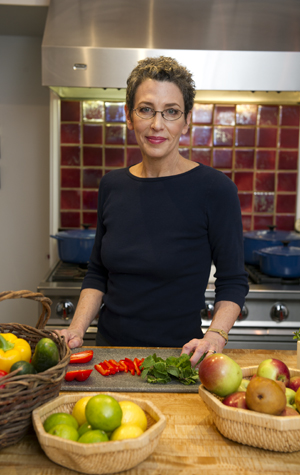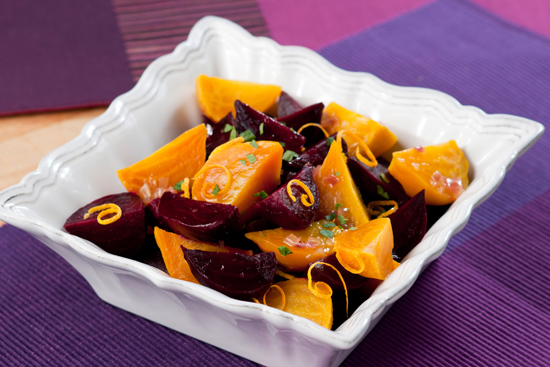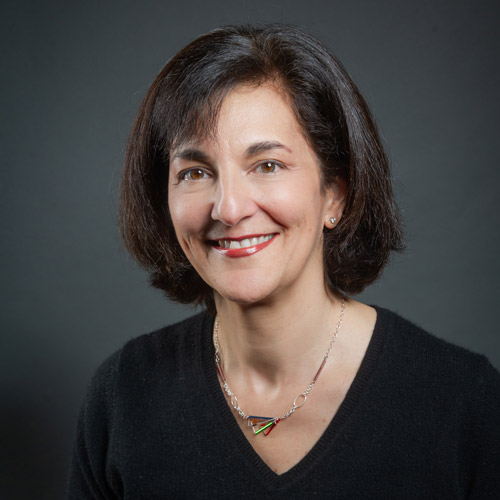Healthful Cooking Made Easy
Alum designs an app for that, with students’ help

Long before cooking became a competitive sport, Deborah Chud’s grandmother was a top chef in her own right—a restaurant owner and caterer who created sophisticated sauces and exquisite, multi-tiered wedding cakes.
“She was the sort of chef who in those days used wine in cooking,” says Chud (MED’84) of her paternal grandmother, Leah Friedson, who lived in Florida. “When my mother met her in 1949, Leah was making stuffed breast of veal with dry white wine. She braised her brisket in dry red wine, rather than the syrupy sweet red stuff that most people served at Passover and Rosh Hashanah.” Chud’s parents shared Friedson’s passion for good food, traveling, and cooking Chinese and French dishes. “They took their first Michelin tour gastronomique of France in 1960,” she says.
Those foodie genes have apparently passed to Chud, now a cook, food blogger, and cookbook author who is using technology in ways Leah Friedson could never have conceived of. With the help of six BU students, Chud has launched Trufflehead, a healthy cooking app for iPhones and iPads with more than 260 recipes, as well as techniques and tips, all aimed at inexperienced and intermediate cooks.
The companion website includes a featured recipe from the app, a “tour” of ingredients and equipment, a section for questions and answers, and blogs written by Chud, as well as other foodies, dietitians, and nutritionists.
The idea, she says, is to show college students and young professionals not just how to follow healthy recipes, but how to become a healthy cook. It’s personal for Chud, who has a 25-year-old son.
Toward that end, the app has lots of the basics. In 170 slideshows, Chud demonstrates how to strain, mince, seed, chop, slice, trim, and cube, among other techniques. An ingredients library explains how to choose and store all manner of produce, from acorn squash to zucchini. The app also includes a table of measurements, a list of recommended equipment, tips on food safety, and information on buying organic foods, using sweeteners, and calculating your carbon footprint.
But basic doesn’t mean bland. Many recipes reflect Chud’s love of ethnic foods, such as cauliflower soup with Moroccan spices, ceviche with avocado, Cuban shrimp, curried mango chicken thighs, five-spice chicken stir-fry, and Korean-style hot pepper meat bundles.
“I cook more ethnic foods than I used to,” says Chud. “Indian cooking is very compatible with my healthy food orientation, because it’s not as fat-dependent as European cuisines are.”
She has included more than 150 vegetarian recipes in the app, such as coleslaw with peppers and roasted beets with Madeira, orange, and honey (see recipe below). And there are more than a few standards, but with a twist: bison burgers with chipotle ketchup and balsamic and sweet onion pot roast.

Student help
While Chud has been at home in the kitchen since she was 10, cooking didn’t become a professional interest until much later.
She studied English at Harvard and went on to earn an MD at BU’s School of Medicine in 1984. She was married as an intern, became pregnant while doing a residency in psychiatry at Massachusetts General Hospital, and left the field for good in 1988. She taught introductory psychiatry at Tufts Medical School for several years.
Over the next 20 years, Chud cooked and began doing work for Zone Perfect Nutrition, founded by the creator of the Zone diet (“a moderate protein, moderate carbohydrate, low-fat diet,” she says). She published a cookbook, The Gourmet Prescription, and created the website A Doctor’s Kitchen, with a new recipe every week and videos and strategies on how to reduce fat and calories.
And she began teaching her son, Sam, to cook healthfully, often fielding questions from him as he shopped for food. “He was constantly calling me,” she says. “What does a shallot look like? How do you make a red wine reduction?” By 2009, she was thinking about writing another cookbook and creating a companion website aimed at inexperienced cooks. Her publicist suggested the app. Even though she’d never used one, she says, “I knew he was right.”
She and Gabe Stein (CAS’11), the BU student she’d hired as webmaster for A Doctor’s Kitchen, began brainstorming. She hired a developer, and over time, five more BU students to help launch the app and trufflehead.com.
Stein says he did a little bit of everything, from coming up with language for the section on organic foods to devising social media strategies, shooting a promotional video, and even picking out color palettes. Brian Sirman (CAS’02, MET’08, GRS’13) typed up the recipes so they were in the proper format for the web developers, compiled master lists of ingredients, equipment, and tags, tested the functions, and did a lot of proofreading. Michelle Rappoli (SHA’12) and Audrey Aiudi (SHA’13) agreed to be guest bloggers on the website. (Rappoli is also credited as a recipe development consultant on the app.) Others who helped on the technical side were Ilir Capuni (GRS’11), a graduate student in computer science, and Brooke Hunter (CAS’11), the backup webmaster. “I could not have done this without them,” Chud says.
Stein, who has built websites for small businesses, friends, and publications (including Quad, BU’s independent online student magazine), says he drew on his web skills and his interest in healthy eating. “I’ve made a lot of websites for a lot of people,” he says, “but it’s much more fun working on something you enjoy and can learn from. I love healthy cooking, and I’ve learned a ton about it working for Deborah. She has a really unique approach to it that makes a lot of sense, which is that people aren’t going to eat healthy unless food tastes good.
“Plus,” he says, “she makes the best spicy chocolate chip ice cream in the world.”
Sirman, who is pursuing a PhD in American and New England studies and teaches in the CAS Writing Program, says he honed a different set of skills on the job: proofreading. He read through every recipe in the app, making sure it matched the original version precisely and that two teaspoons didn’t end up as two tablespoons.
Like Stein, Sirman often turns to the app in the kitchen. “I’ve cooked several of the recipes,” he says. “My favorites so far are the different variations of sleepover oats, which I make for breakfast at least two or three times every week.”
That’s the kind of review Chud likes to hear. Her mission, she acknowledges, is fairly grandiose. “I would love to teach my son’s generation to cook healthfully,” she says. “And I believe I can.
“I believe I can make a contribution to the health of young people. And speaking of young people, I know of a nine-year-old who is cooking from Trufflehead. She’s the daughter of the Trufflehead project manager. So I know people can do it.”
Roasted Beets with Madeira, Orange, and Honey
This gorgeous, festive, entertaining-friendly dish has “holiday” written all over it. You can roast the beets and prepare the sauce up to three days in advance. Refrigerate them in separate covered containers. Then, just before serving, spoon on the sauce, microwave to warm, sprinkle with parsley, and dazzle your guests. Serve with roast turkey, pork, duck, or beef. Leftovers are delicious cold, right out of the fridge.
Ingredients
- 2 pounds beets without greens or 4 pounds with greens attached (stems trimmed to 1 inch), scrubbed and dried
- 1 tablespoon extra virgin olive oil
- 2 shallots, minced (2 tablespoons)
- ½ cup Madeira
- 1 tablespoon frozen orange juice concentrate, thawed
- 1 tablespoon honey
- ½ teaspoon grated orange zest
- salt
- freshly ground black pepper
- 2 tablespoons minced flat-leaf parsley (leaves from about ¼ medium bunch), optional
To prepare
- Preheat oven to 400º F.
- Wrap the beets in individual foil packets. Seal by crimping to make as airtight as possible. Place on a rimmed baking sheet and roast 1 hour. Wearing protective gloves, open 1 packet and test doneness with a fork (the fork should pierce it easily). If not done, reseal the packet and return to the oven for 15 minutes, or longer if necessary.
- While the beets are roasting, place a small saucepan over medium heat. When hot, add the oil. When oil is hot, add the shallots. Cook, stirring occasionally, 2 to 3 minutes, until soft. Add the Madeira. Increase the heat to medium-high and bring to a boil. Cook until syrupy, about 5 minutes. Remove from the heat and stir in the orange juice concentrate, honey, and zest. Set aside.
- Remove beets from the oven. Wearing protective gloves, open the packets to release the steam. When the beets are cool enough to handle, peel and quarter them. Transfer to a serving dish.
- Drizzle the Madeira mixture over the beets and season to taste with salt and pepper. Toss to coat and sprinkle with minced parsley if desired. Serve hot, warm, or at room temperature.
Makes 6 servings. Per serving: 103 calories, 2 g total fat, trace saturated fat, 0 mg cholesterol, 14 g total carbohydrates, 3 g dietary fiber, 2 g protein, 81 mg sodium.

Comments & Discussion
Boston University moderates comments to facilitate an informed, substantive, civil conversation. Abusive, profane, self-promotional, misleading, incoherent or off-topic comments will be rejected. Moderators are staffed during regular business hours (EST) and can only accept comments written in English. Statistics or facts must include a citation or a link to the citation.